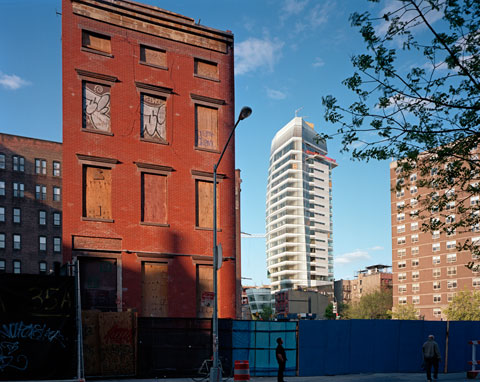
East 4th Street and the Bowery (4×5 film)
The 4×5 version of the image posted earlier. Samuel Tredwell Skidmore House in foreground; new hotel tower by Carlos Zapata.
Ran into Alex Harsley, the photographer, on Second Avenue yesterday. He nailed me with his cell phone, so I returned fire. Later, I went by his gallery/studio on East 4th Street with my son Brendan. Alex is busy with videos these days, but it’s his remarkable still photography that interests me the most.
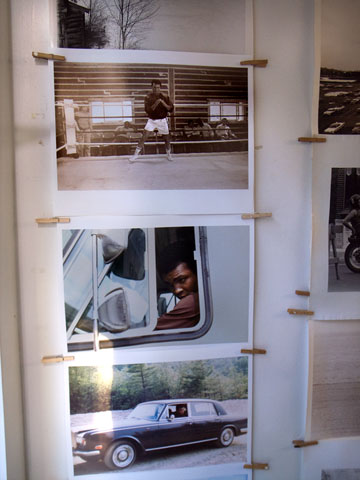
Muhammad Ali by Alex Harsley (digital)
Covering the walls of his tiny gallery space are dozens of images, held up by clothespins, made over the decades of New York scenes–especially the Lower East Side–with many chronicling African American culture. I snapped a piece of one wall showing several photos of Muhammad Ali. Who knows what else is in his archive. I can only only speculate. Drop by and visit. (67 E4th Street)
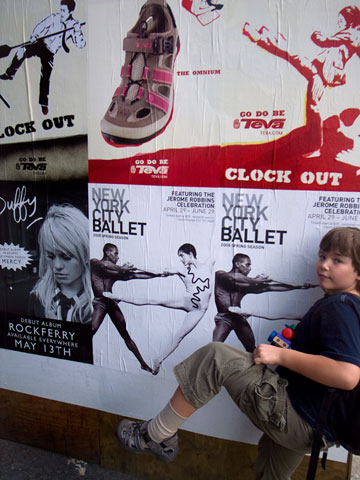
Brendan on the Bowery (digital)
New kicks.
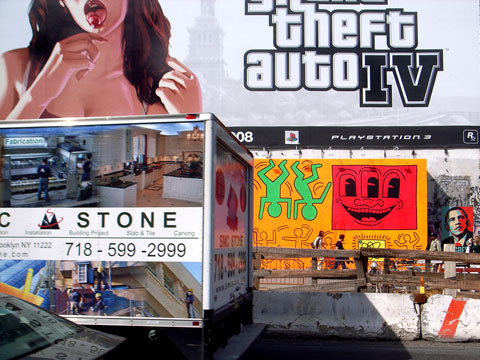
Houston Street and the Bowery (digital)
A recreated Keith Haring mural, Barack Obama, and Grand Theft Auto IV conjoin at Houston and Bowery.
I shot about 10 sheets of 4×5 film from several different angles with different arrangements of people and cars. The Obama poster is more prominent in some. It’s probably the most photographed corner in New York at the moment, not that that has ever deterred me.
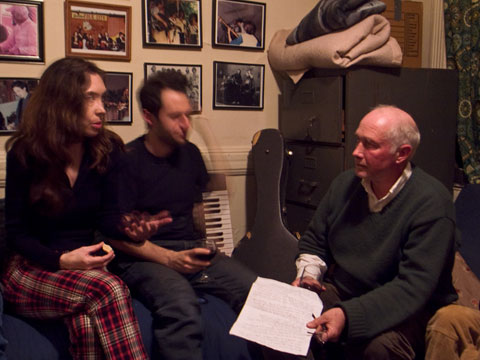
Jack Hardy with songwriters at his apartment on Houston Street. (digital)
It’s been a while since I wrote a song–something I’ve been doing since I was 20 years old–what with photography and family responsibilities taking up my time. Last Monday I went Jack Hardy’s weekly songwriter meeting at his battered tenement apartment on Houston Street in the Village. I went with a new song to premiere and subject to the critical ears of a roomful of writers of all levels of accomplishment.
Lyrics don’t always read so well on the page, but I think these hold up:
underground
the man in the coat looks uncomfortably hot
he prays from a book he rocks back and forth
the train rumbles through the rock blasted earth
eyes shift in sockets there’s a bulge in a pocket
ipods play private reveries
chorus:
roll on roll on subterranean train
through the blind tunnel of fate
roll on roll on with a fearful freight
if you see something say something
before it’s too late
school kids swarm in and swing from the poles
a mariachi band plays besame mucho
a family from somewhere not anywhere near here
clings to their map of the world underground
ipods play private reveries
down in the glare air conditioned hades
fire and brimstone in an unattended package
each sudden lurch and with each random search
eyes pry deeper into unattended musings
ipods play private reveries
The “see something say something” bit will be familiar to riders of the New York City subway. It’s an ad campaign calling for vigilance on the part of the public, but many of us regard it as furthering an atmosphere and politics of fear.
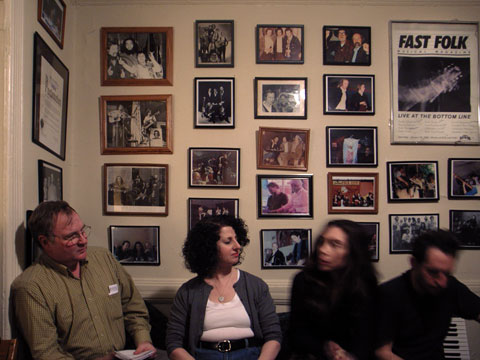
Jack’s apartment is lined with photos of the famous and almost famous. (digital)
The song went over well at Jack’s, but there were many good songs that night. It’s not always that way. It can be tedious at times, but then, without warning, the most remarkable compositions emerge.
On Friday I went to the Postcrypt Coffeehouse, a basement music venue at Columbia University. Tim Robinson, a frequent contributor to the Monday evening meetings at Jack’s, was host, and his guests were Suzanne Vega and Richard Julian. The three of them took turns playing songs–whatever seemed appropriate at the moment–and the audience, most of whom didn’t know that Suzanne and Richard were appearing, were enthralled.
I’ve known Suzanne for many years, and at this point, I guess she’s one of my oldest friends. Richard I met some years later when he began coming to Jack’s and hanging out with our circle of songwriters. Richard was great then, but his writing and performing have matured and developed like nothing I’ve ever seen. His songs are accessible, but also sophisticated, witty, and profound. Where many of us struggle with our little melodies and chord progressions, Richard does things musically I can only begin to understand. He’s seeing some well-deserved success these days–Norah Jones has covered a couple of his songs–and the Times has written him up more than once. He used to sing back-up vocals for me.
Tim Robinson I met more recently, also at Jack’s. He’s an extraordinarily literate songwriter who is recognized by people like Suzanne and Richard, but still struggles to find a wider audience. The record industry no longer (if it ever did) shows interest in people like Tim, and he, like many others, are left to record on their own and distribute their music in alternate ways. I expect him to endure and prosper as an artist, regardless of the trappings of success. Look him up.
The weather was beautiful today in New York. Cool, but crisp and comfortable. I worked on an assignment in the early morning light, and in the late afternoon walked up the Bowery north of Houston Street doing several photographs with the view camera around 3rd and 4th Streets.
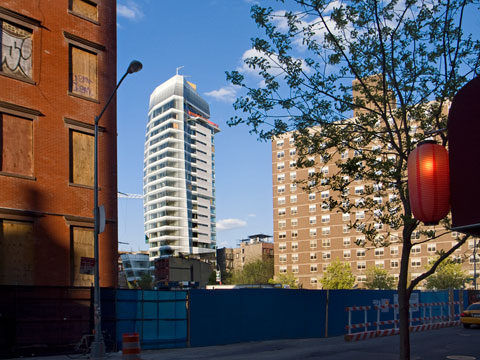
East 4th Street and the Bowery (digital)
There’s a lot of construction in this area–Cooper Union’s new building, a hotel, and an apartment tower rising above a row of mostly 19th century buildings on the Bowery. The hotel is by Carlos Zapata, best known for Soldier Field in Chicago, a controversial architectural insertion into a historic stadium structure. Here the white accented glass reminds people of the Frank Gehry IAC building on the west side. Over there, the billowy Gehry building sails confidently along among older warehouses and factories. Here, the first impression is of an overly shrill, snooty, tower giving the cold shoulder to the humble tenement surrounding. But I am cautious about rushing to judgment on unfinished buildings. Only when it and the adjacent Thom Mayne (Cooper Union) building are complete will it be possible to assess the effect on the neighborhood–and on each other.
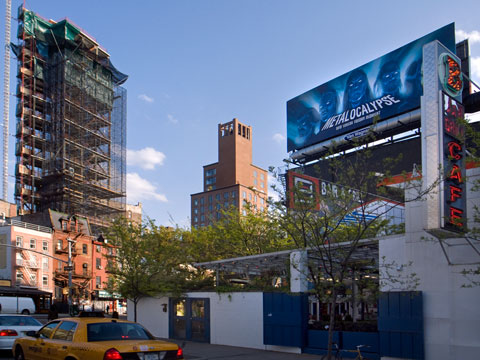
East 4th Street and the Bowery (digital)
This is where my life in New York began–Cooper Square and the block of East 4th Street between the Bowery and Second Avenue. Looking at these pictures, it seems an unfamiliar world, despite the fact that most of the older buildings remain.
A spring picture–from a year ago, actually–but one that I’ve just gotten around to scanning. It shows the Bowery Hotel under construction, and a couple of pre-Civil War structures that survived the wave of tenement buildings that replaced most of the townhouses in the area. This picture was taken on East 2nd Street between the Bowery and Second Avenue.
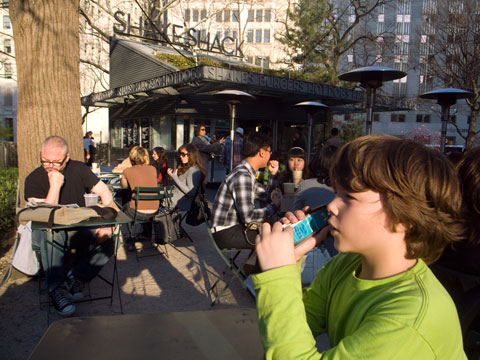
Brendan holding order buzzer at the Shake Shack
Today was sunny and warm–the first really warm day of Spring. Brendan and I hit the Shake Shack in Madison Square Park beneath the Met Life clock and a stone’s throw from the Flatiron Building. The line was 15 minutes, but was twice as long when we left. A bevy of nuns in full habit sat nearby, probably in town for the Pope’s visit.
I let my 9 year old son Brendan stay up and watch the ABC News Democratic debate because he has become interested in the campaign and wants to feel a part of what is going on. He is broadly familiar with the big issues like the war in Iraq, global warming, poverty, etc. After 30 minutes of flag pins, guns and religion, sniper fire, names like Wright, Ayers, and Farrakhan, my son asked, “Dad what are they talking about?” “Why are they talking about hunting?”
Things did not get better, so I shut off the TV and sent my son to bed. What had been meant as an exposure to the democratic process, however imperfect, turned into an insulting display of big media arrogance and stupidity. Although it appeared to me to be a hatchet job on Obama (I admit to being biased), I felt it made a mockery of both candidates, the election process, and democracy as a whole. I do not think that ABC should get away with this unpunished. And Charlie Gibson and George Stephanopoulos, the moderator and questioner, should be hounded into early retirement.
One of the reasons for visiting Flushing was to do a photograph for an article being written by my wife for a Dutch magazine on the sub-prime mortgage issue. She is an urban planner, currently working on the staff of Community Board 4 (Chelsea and the west side of Midtown). Most of the sub-prime-related foreclosures have been in the so-called outer Boroughs, Queens being one of the hardest hit. It’s definitely a “tale of two cities” (please forgive the cliché) with Manhattan and the more prosperous neighborhoods of Brooklyn and Queens virtually untouched by the mortgage crisis while lower income, mostly black and hispanic, neighborhoods suffer.
I took the 7 train out to Main Street Flushing, which has become a largely Asian area, something that is immediately visible to all. I walked through some surrounding residential neighborhoods where two and three story row houses are making way for tall apartment blocks, often in jarring fashion. It’s clearly evidence of a hot real estate market, but whether the recent mortgage mess is slowing things down, I don’t know. In any case, I was pleased to get this somewhat enigmatic image of empty row houses surrounded by tall wooden fencing and apartment high rises under construction in the background.
Back in Manhattan.
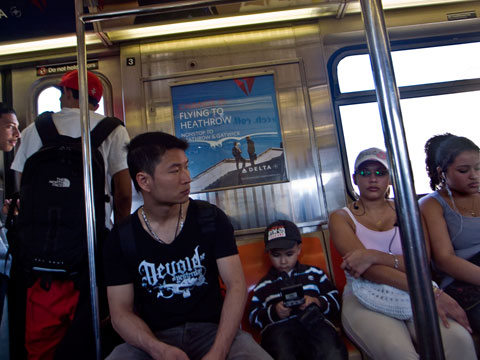
The 7 train on the way to Flushing, Queens
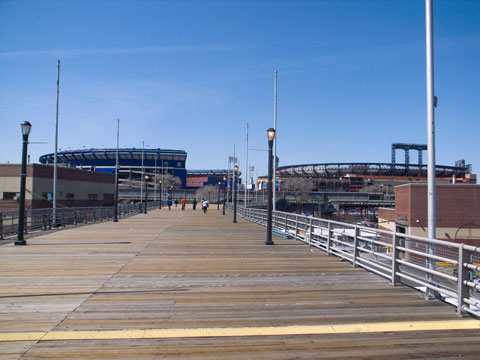
Shea Stadium (left) and Citi Field (right)
I took the 7 train out to Flushing to scout a location for later photography. Along the way, I stopped at Shea Stadium where a new Mets stadium, Citi Field, is under construction. For a short period of time we have two stadiums next to one another. The modern looking stadium is older, and the old timey stadium is newer. I like some of the retro ballparks in other cities that relate to the surrounding urban fabric. Here in Flushing, the immediate context includes a potholed street of auto body shops and junkyards that looks like Baghdad outside the Green Zone, neighborhoods of monotonous row houses, and to the south, Flushing Meadows Park, the former grounds of the back-to-the-future 1964/65 World’s Fair. So, given the choice, the stadium designers went with downtown Baltimore a la Camden Yards. That said, however, I think it will be a better ballpark for enjoying a game than the current Shea Stadium. Unlike Shea, it will be a dedicated baseball venue.
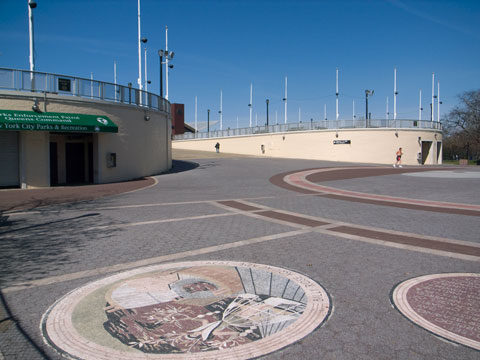
Gotham Plaza, Flushing Meadows Park
There are a few structures leftover from the World’s Fair, the most notable being the Unisphere and the embarrassing ruins of the New York State pavilion. As one descends from the subway platform into the park you can still see some of the fair structures and mosaics that were, apparently, done in 1998. One of them is a sardonic smiling Robert Moses–based on an image by Andy Warhol. Moses, of course, was the infamous master builder of New York throughout much of the 20th century who was also responsible for the World’s Fair.
I am hooked on a photo blog called Shorpy in which members post photographs from the 19th and first part of the 20th century. Some of the images are are from FSA photographers such as Dorothea Lange, Russell Lee, and Jack Delano. There are over 200 Lewis Hine images on Shorpy, mostly of children working in factories and mines. Shorpy was Shorpy Higginbotham, a young boy photographed by Hine who was employed in a coal mine in Alabama. He’s the mascot, if you will, of the blog.
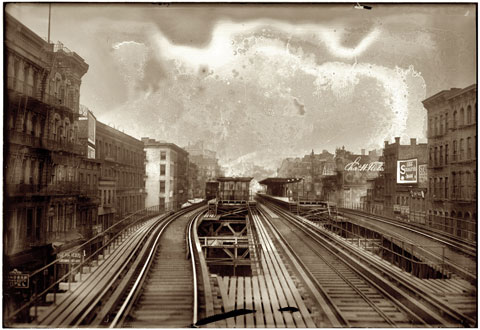
The Bowery at Houston Street, 1910, George Grantham Bain Collection
Here’s a recent post from Shorpy of the Bowery in 1910 just around the corner from my office/apartment on Stanton Street. The photographer, apparently, is unknown. It’s a stunning view of the scene along the Bowery just about 100 years ago. Elevated railroads ran up and down Third Avenue and the Bowery, smoke belching–the noise, undoubtedly, deafening.
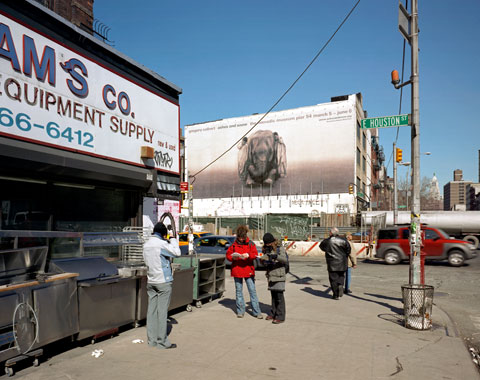
The Bowery at Houston Street, 2006 (4×5 film)
The photograph above was taken just to the left of the photographer’s more elevated vantage point in the historic image. Houston Street, originally a narrow street, is now a roaring river of crosstown traffic separating the neighborhoods above and below. Soho, short for south of Houston, and Noho, north of Houston, exist as named places because of their relation to this thoroughfare. The street was first widened, I believe, when subway tunnels were built underneath using cut and cover construction, which required demolishing a swath of buildings across Manhattan. The F, D, and B trains run beneath Houston. As a result, there are many blank walls along the street where buildings previously stood.
The restaurant supply building to the left in my photograph is also in the historic photo above.
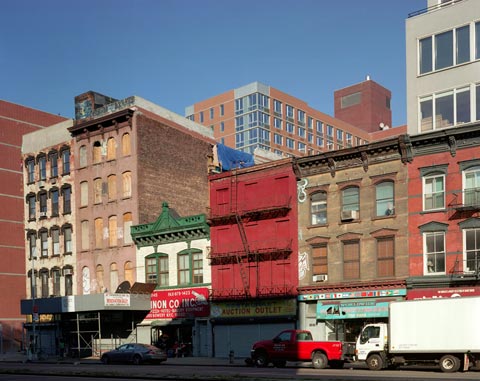
The Bowery between Stanton and Houston, 2007 (4×5 film)
In the picture above, made with a view camera, the two old buildings at left can be seen in the far right of the historic image. The new apartment building in the rear occupies the space taken by the next five small buildings. Although the remaining stretch of 19th and early 20th century buildings above is probably safe from immediate demolition, much of the historic Bowery is up for grabs.
Continuing with photographs I made on several walks through Berlin Mitte before the Wall came down. The most obvious thing one noticed when crossing the border to East Berlin was the profound devastation still visible from World War II 42 years after the fact. The DDR had taken on a number of big urban renewal projects, especially along Frankfurter Allee, which was temporarily called Stalin Allee. Much of Mitte, however, the center of the city closest to the Wall, was largely untouched.
At the time of my photographs the East Germans were turning their attention to Mitte, and considerable demolition and rebuilding was underway. Fortunately, the fall of communism put a stop to the shoddy construction filling the gaps left by the war or by the wrecking ball.
Walking around East Berlin with the view camera I felt more conspicuous than usual–I doubt that there were any view cameras in use in the DDR in those days–and I was given a wide berth by nearly everyone. One man, however, in longish hair and slightly unkempt appearance came up to me and asked what I was up to. I attempted to explain in my limited German that I was making urban landscape photographs.
He asked whether I was interested in social/political issues as a photographer, and I denied having any particular ax to grind along those lines. He then suggested that photographing urban landscapes could, in fact, encompass all those issues, even as the images stylistically presumed to remain neutral. I felt utterly unmasked at that point, not simply in what I was doing in East Berlin, but what I was doing in general as a photographer.
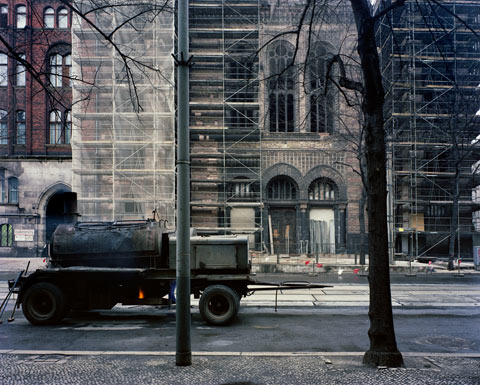
Neue Synagoge, Oranienburger Strasse, Berlin, 1987 (4×5 film)
I’ve been scanning a series of pictures I made in 1987 in what was then East Berlin. This was a somewhat difficult proposition given the nature of the communist state of the DDR. Carrying a view camera across the border elicited the attention of the border agents, who nevertheless, let me through. I always said that I was interested in Schinkel architecture, which was true up to a point. In retrospect I wish I had photographed Schinkel architecture back when everything over there was frozen in a post-war decrepit condition. But I did wander the streets of Berlin Mitte avoiding, as best I could, the gaze of the Volkspolizei, as I photographed the desolated neglect of the city.
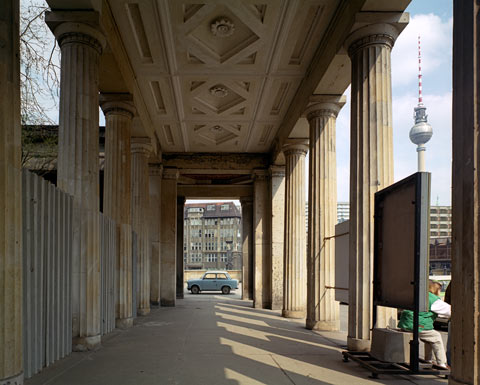
Bodestrasse, Berlin, 1987 (4×5 film)
I probably did three days of shooting all together. It was just too stressful for me. I figured at some point I would be detained for questioning, or worse. That almost happened when I went with my American friend Anamarie Michnevich in search of early 20th century modernist housing to photograph. What we found, entirely by accident, was the headquarters of the notorious Stasi, the East German secret police. Guards suddenly appeared and began pointing and calling out. We dashed down a subway stair just as a train entered and we zipped out of there. That was it for me. I gave up on doing more East Berlin photography.
I will post more photographs in the coming days.
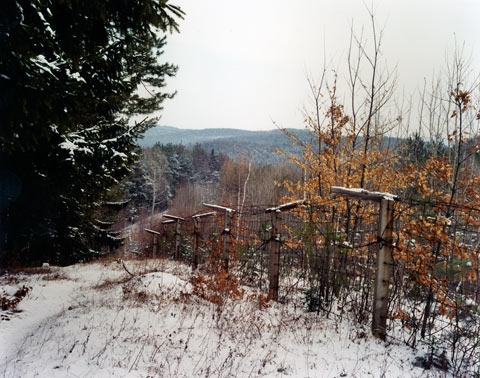
Barbed wire fence along the Austrian/Hungarian border, 1987 (4×5 film)
There was an interesting article in today’s New York Times about former East Germans who attempted to escape the communist state of the German Democratic Republic (GDR) by a circuitous, and dangerous, route through Bulgaria. For those of you unfamiliar with the Iron Curtain, it was a mostly fortified border separating east and west that stretched all the way across Europe. In my Lost Border project I followed the borderline from the Baltic Sea in the north to the Adriatic in the south. That meant that I defined the Iron Curtain as running along the eastern edge of Yugoslavia where it touched Austria and Italy. Technically, Yugoslavia was not a part of the Soviet Bloc, but in practice, it was a communist country allied with the east.
I could have included the border separating Bulgaria from Greece and Turkey as well as the line between Finland and the Soviet Union. Rather than travel hundreds of miles of Finnish forest or trek through the mountains of the Bulgarian frontier, I chose to limit my project to the continuous line dividing continental Europe.
The reason that East Germans entertained the idea of fleeing across the Bulgarian border was that it was not fenced, or walled like it was in Germany, Czechoslovakia, and Hungary. While East Germans could not travel to the west, they could move about more or less freely in East Bloc countries. Many believed that the southern border offered a comparatively easy dash to freedom across open, though rugged, landscape. In reality, the border was heavily patrolled, and guards routinely shot to kill.
The Times article is based on the work of researcher, Stefan Appelius, a professor of political science at Oldenburg University, who estimates that some 100 East Germans were killed attempting to escape across the Bulgarian border. The article focuses on a couple, Olaf and Barbara Hetze, who made the attempt, unsuccessfully. They survived–she was shot, and he arrested–but eventually the West German government bought their freedom in an arrangement used frequently by the German Democratic Republic to procure western currency.
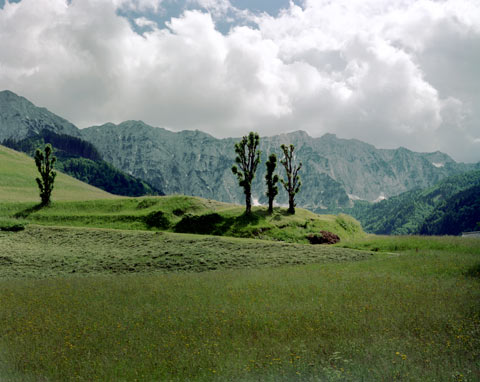
Mountainous terrain of the Austrian/Yugoslav border, 1985 (4×5 film)
Likewise, there were many attempted escapes by East Germans along the Czech, Hungarian, and Yugoslav borders. Only the Yugoslav border was unfenced, but its mountainous terrain and attentive border guards made flight near impossible. In fact, while making one of several border trips with my camera, I read in a local paper of an escapee who had been fatally shot by a Yugoslav guard, despite reaching Austrian soil. Such incidents occurred with some regularity contributing to the always tense atmosphere along the frontier, not to mention feeding international tensions between east and west.
The article is somewhat confusing in that it reads as if one had only the choice of escaping over the Berlin Wall or finding a way to run for it in Bulgaria. The Iron Curtain extended thousands of miles across Europe tracing a course through fields, forests, mountains, and even splitting villages. Escape was difficult everywhere, though, perhaps, easier in some places than others. I even recall hearing, or reading, about two men who escaped from East Berlin by traveling all the way to China where they were smuggled to the west by Canadian diplomats. They ended up in West Berlin only a few meters away from where they started.